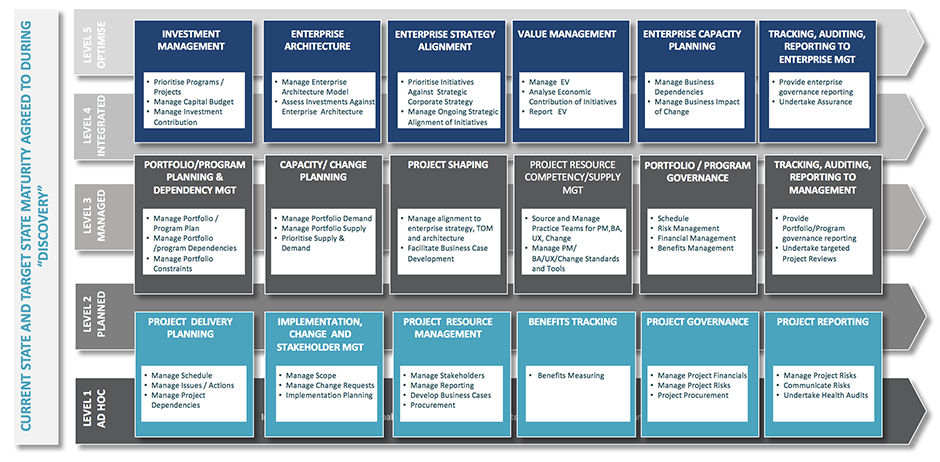Scale, cost, and value: What are the key considerations when deciding to keep your PMO in-house vs outsourcing it?
A Project Management Office (PMO) can be an essential component for the successful delivery of any large program (Program PMO), delivering to a technology roadmap (Technology PMO), or indeed, the ongoing management of a diverse slate of projects (Enterprise PMO).
But where do they best sit: In-house or outsourced? Both approaches have merit. The question is then what is the optimal model for the PMO and how can it be determined?
Cost centre or scalable resource?
If we define a PMO as a business unit that provides a suite of capabilities operating to enable, govern, and manage risk associated with the delivery of projects in an organisation, then it may contain some of the capabilities in the figure below:

In many organisations, the PMO is seen as a separate cost centre existing to support the effective delivery of projects and it often gets rolled up under IT or Finance as a component of overall project spend. It can also be seen as a cost centre, rather than a value provider, which may reduce the money available to deliver the portfolio and as such, at times, be a sitting duck when cost pressures dominant conversation.
In some instances, the PMO is dissolved on the basis that the risk in project delivery is insufficient to carry the cost of a PMO; in other instances, there is recognition that its capabilities may still be required but need to scale up or down to match the delivery portfolio demands. It’s the latter that is likely to fuel the desire to outsource the PMO and have a PMO-as-a-service model to ensure that supply and demand are well-balanced and costs contained.
So how can an organisation determine which is best?
The Guiding Principles of Organisational DNA
To go about answering this challenge we need to start with a few guiding principles (or realities).
Each organisation has its own delivery “DNA”, by which we mean culture, capability and capacity. The unstated tacit knowledge of an organisation and how to be effective within it often outweighs the value of a suite of tools and templates to be followed to deliver a project. That does not mean the tools and templates are not required, however it highlights that a recipe alone is not enough for ensure effectively delivery.
The capabilities a PMO provides are necessary for consistent and predictable effective project delivery. That does not mean a PMO must exist to provide them. However, the capabilities need to be present and, very importantly, work together seamlessly. Without service integration, the effectiveness to support and enable successful delivery is significantly compromised.
What Capabilities Do We Have or Not Have?
The next step in looking at your PMO and where and how the capabilities are provided is to triage them into two groups, being commodity capabilities (services) and bespoke capabilities.
Commodity capabilities (Category A) are those that readily exist in the marketplace, do not require an understanding of the organisations DNA and do not provide any competitive advantage to the organisation. One example might be Master Scheduling.
Bespoke capabilities (Category B) on the other hand are those that need to be learned, are particular to the organisation, and support or enable the competitive advantage, tacit knowledge of, and DNA of the organisation as implicit within the capabilities. One example might be Portfolio Prioritisation.
When working through these challenges, Quay uses our PMO Capability Model as the framework to ensure we can have these informed discussions with clients. Typically, the capabilities within Category A (i.e. commodity capabilities) lend themselves to potential outsourcing and those in Category B (bespoke capabilities) are best serviced within the organisation itself.
Integration is Key – And Critical
Finally – and importantly – once there is clarity around a target operating model for the PMO (which may be a blend of in-house and outsourced), the organisation needs to work through how each capability will work together to ensure that they are operationally integrated and support effective delivery.
Like almost everything, there is never one simple answer to the in-house vs outsourced options. The key to getting the shape and construction of your PMOs right to deliver the maximum value will be greatly assisted by developing your own PMO operating model, then working through what works best for your organisation.
We believe that quality thought leadership is worth investing in. Please share our content with your colleagues via any of the links below.
Want to talk to us about PMO? Contact us here or call 02 9098 6300.

